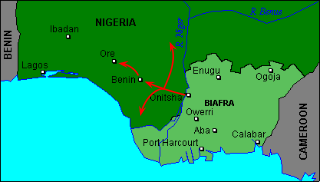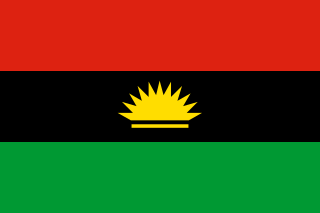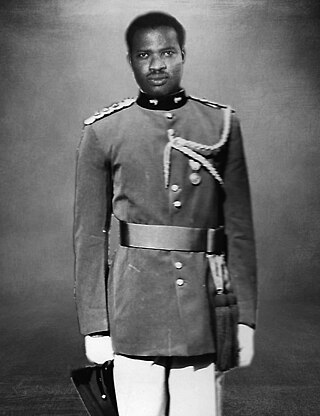
The Nigerian Civil War, also known as the Biafran War, was a civil war fought between Nigeria and the Republic of Biafra, a secessionist state which had declared its independence from Nigeria in 1967. Nigeria was led by General Yakubu Gowon, and Biafra by Lieutenant Colonel Chukwuemeka "Emeka" Odumegwu Ojukwu. The conflict resulted from political, ethnic, cultural and religious tensions which preceded the United Kingdom's formal decolonisation of Nigeria from 1960 to 1963. Immediate causes of the war in 1966 included a military coup, a counter-coup, and anti-Igbo pogroms in the Northern Region. The pogroms and the exodus of surviving Igbos from the Northern Region to the Igbo homelands in the Eastern Region led the leadership of the Eastern Region to conclude that the Nigerian federal government would not protect them and that they must protect themselves in an independent Biafra.

Rolf Steiner is a German retired mercenary. He began his military career as a French Foreign Legion paratrooper and saw combat in Vietnam, Egypt, and Algeria. Steiner rose to the rank of lieutenant colonel commanding the 4th Commando Brigade in the Biafran Army during the Nigerian Civil War, and later fought with the Anyanya rebels in southern Sudan.
David Hugh "Taffy" Williams was a Welsh-born South African mercenary who fought for the State of Katanga during the Congo Crisis (1960–1963) and the Republic of Biafra during the Nigerian Civil War (1967–1970).
Operation OAU was a battle between Nigerian 3 Marine Commando Division (3MCDO) and Biafran 12 Division in modern day south-eastern Nigeria. Operation OAU was an intermittent battle that may have resulted in over 25,000 deaths on both sides. Although the Biafran soldiers were outnumbered, they were able to retain control of Umuahia and eventually recapture the cities of Owerri and Aba.

The fall of Enugu was a military conflict between Nigerian and Biafran forces in September and October 1967 during the Nigerian Civil War which centered around Enugu, the capital of the secessionist Republic of Biafra. Nigerian federal forces had made Enugu's capture a priority shortly after war broke out, but their advance stalled at Nsukka. Biafran president and leader Odumegwu Ojukwu, attempted to distract the Nigerian Army by initiating an invasion of Nigeria's Mid-Western Region in August, but the offensive was brought to a halt. Lieutenant Colonel Theophilus Danjuma took charge of the Nigerian forces at the Nsukka front and prepared to advance on Enugu with seven battalions of the 1st Division. Enugu was garrisoned by one brigade led by Colonel Alexander Madiebo and poorly armed civilians called into service. Danjuma decided to launch an offensive with his forces spread over a broad front to make it more difficult for the Biafrans to block them along major roads as had happened up to that point.
The siege of Owerri was a battle between Nigerian and Biafran forces in the Nigerian Civil War. The capture was a major victory for the Biafrans because the victory opened up telephone lines, enhanced road telecommunications, and showed that with stiff resistance, Biafra could defeat Nigerian forces.
The Operation UNICORD was an offensive launched by the Nigerian Army at the beginning of the Nigerian Civil War. It involved the capture of 6 major Biafran towns near their northern border.
The Invasion of Port Harcourt was a military conflict between Nigerian and Biafran military forces.
Operation Tail-Wind was the final military conflict between Nigeria and Biafra. The operation took place in the towns of Owerri and Uli, both of which were captured by Nigerian forces. The operation ended with General Odumegwu Ojukwu fleeing to the Ivory Coast and then president of Biafra Philip Effiong surrendering to Olusegun Obasanjo.

The Midwest Invasion of 1967 or Midwest Offensive, codenamed Operation Torch, was a military operation between Nigerian and Biafran military forces during the Nigerian Civil War. The invasion began on August 9 when 3,000 Biafran soldiers led by General Victor Banjo crossed the River Niger Bridge into Asaba. Upon reaching Agbor, the Biafrans split up. With the 12th Battalion moving west capturing Benin City and Ore, the 18th Battalion swung south, taking Warri, Sapele and Ughelli, while the 13th Battalion headed north for Auchi, Agenebode and Okene. Simultaneously, a plot to capture Mid-Western Governor David Ejoor at his home in Benin failed. Nevertheless, the Biafrans, meeting virtually no resistance, had seized the entire Mid-Western Region in less than 12 hours.
The First Invasion of Onitsha was a battle and military offensive fought during the Nigerian Civil War between Biafran and Nigerian forces. The Nigerian Army's 2nd Division managed to seize control of Onitsha for less than a day before being pushed out and crushed by Biafran soldiers.
The Abagana Ambush was an ambush during the Nigerian Civil War by Biafran troops led by Major Jonathan Uchendu that wiped out the Nigerian 2nd Division. Of the 6,000 Nigerian troops ambushed, only a very small number survived, including the 2nd Division's commander, General Murtala Muhammed.
The Second Invasion of Onitsha was military conflict between Nigerian and Biafran military forces.
Operation Leopard was a military operation conducted against Biafran troops defending Umuahia. No fighting took place inside Umuahia but the area surrounding it was heavily devastated by the Nigerian offensive. Umuahia was finally captured by Nigerian troops on April 22, 1969.
Ogbunigwe, also called Ojukwu Bucket, was a series of weapons systems including command detonation mines, improvised explosive devices, and rocket-propelled missiles, mass-produced by the Republic of Biafra and used against Nigeria between 1967 and 1970 in the Nigerian Civil War.

Ogbugo Kalu was a Nigerian military officer who served in the Nigerian Army and later the Biafran Army during the Nigerian Civil War. Kalu was also commander of the Nigerian Military Training College (NMTC) in Kaduna following the 1966 Nigerian coup d'état.

The Biafran Armed Forces (BAF) were the military of the Republic of Biafra, which existed from 1967 until 1970.

Ejike Ebenezer Obumneme Aghanya was a military officer and electrical engineer who served in the Nigerian Army and the Biafran Armed Forces, retiring as a colonel. Accused of involvement in the 1966 Nigerian coup d'état he was arrested and imprisoned without trial until the outbreak of the Nigerian Civil War where he served on the side of Biafra, holding key positions in the Biafran Armed Forces. He was the head of the Biafran Agency for Research and Production (RAP) which produced bombs, rockets, missiles, as well as ammunition, armored vehicles, telecommunication gadgets and petroleum refineries among others for the Biafran Armed Forces. Later he was the Chief of Staff of the Biafran Organisation of Freedom Fighters (BOFF) which was the guerrilla warfare and special operations arm of the Biafran Armed Forces. He also served as Battalion Commander, 44th Electrical and Mechanical Engineer Battalion Biafran Army and later Brigade Commander of the 58th Brigade of 12th Infantry Division Biafran Army during the war.
Marc Goosens was a Belgian mercenary who fought in the Yemeni Civil War and served in the army of Biafra during the Nigerian Civil War. He was killed by Nigerian forces in Onitsha during Operation Hiroshima.
Alexander A. Madiebo was a Biafran soldier. He served as the General Officer Commanding (GOC) of the Republic of Biafra which existed from 1967 to 1970.







